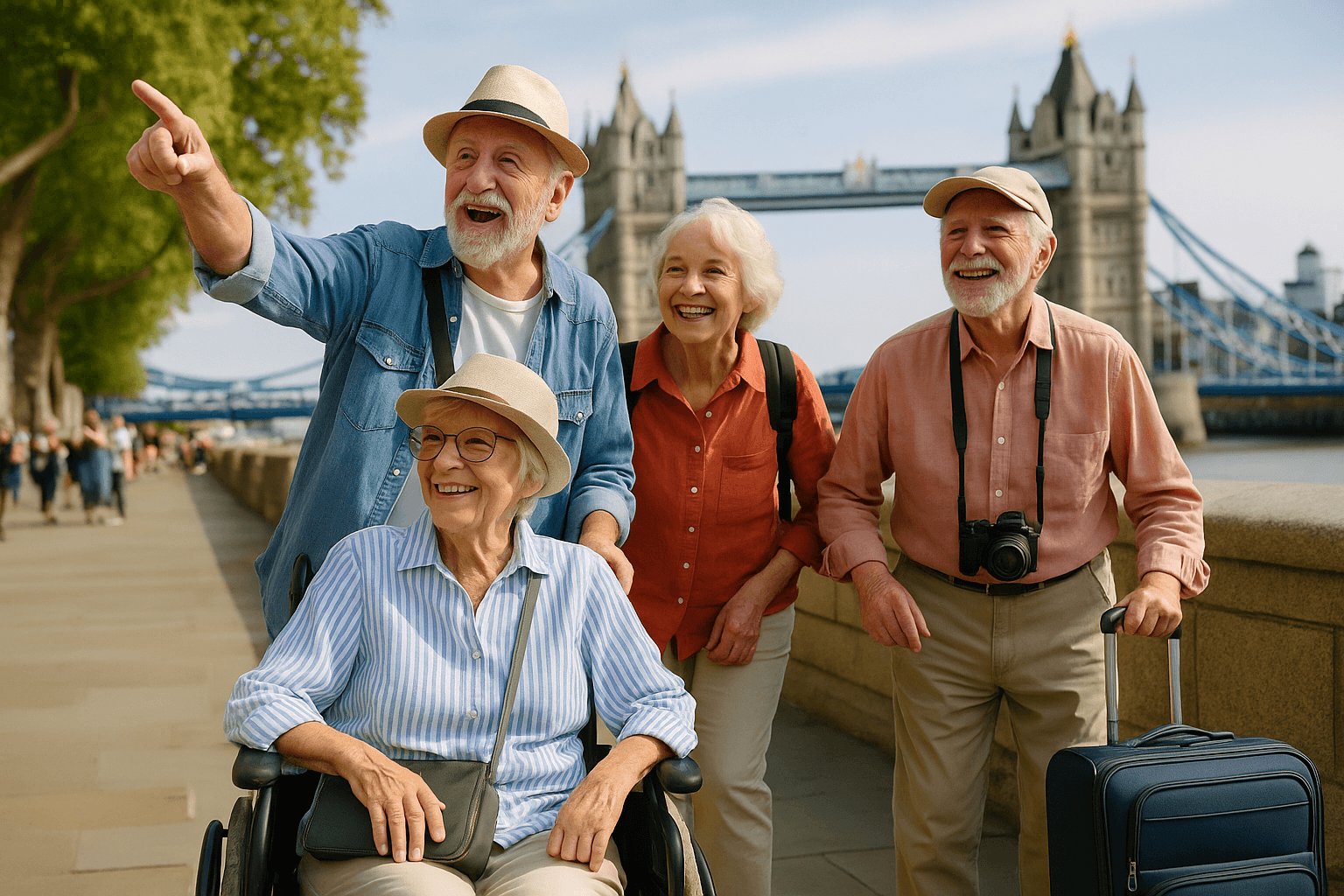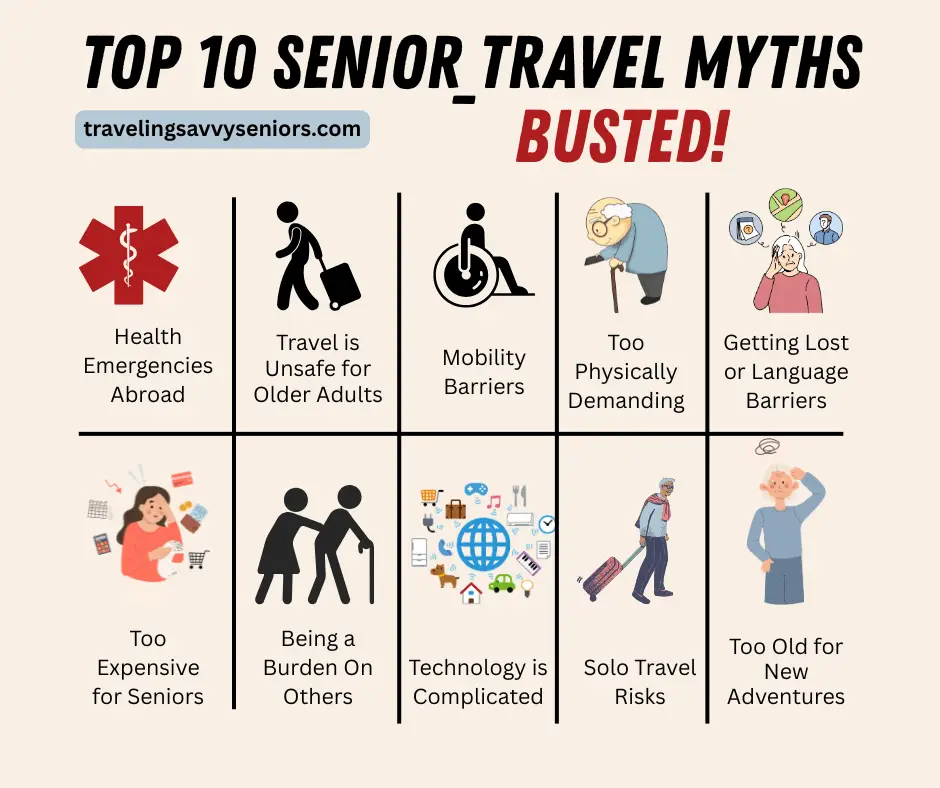Top 10 Accessible Travel Destinations for Seniors
Traveling in your golden years should be inspiring – not intimidating. Yet senior travelers with mobility challenges often face pain points that younger tourists might not consider. Common hurdles include limited wheelchair access on transportation (from flights to local transit), hotels lacking grab bars or ramps in accommodations, and difficulties navigating attractions with stairs or uneven paths. There can also be concerns about finding nearby medical facilities for peace of mind, as well as managing costs on a fixed budget. Even language barriers and the rapid pace of new technology, such as booking or navigation apps, can pose challenges. Fortunately, many destinations around the world are rising to meet these needs with robust accessibility features, senior discounts, and health infrastructure. Below, we highlight 10 of the best accessible travel destinations – a mix of international hotspots and U.S. gems – that excel in senior-friendly travel.
1. London, UK
London has earned recognition as one of Europe’s most accessible cities cntraveller.com. Despite its historic architecture, the city offers an impressive range of accessible amenities for senior visitors. Over half of London’s restaurants and a large share of its attractions are wheelchair-accessible, according to cntraveller.com, meaning you can enjoy everything from the British Museum to West End theaters with relative ease. Many black-cab taxis are ramp-equipped, and all public buses are low-floor, allowing for step-free boarding. The Tube (metro) has been retrofitting stations with lifts; while not every stop is step-free, planning routes in advance can avoid the older stations. London’s commitment is such that a 2024 survey ranked it the #1 most accessible city in Europe, given the abundance of accessible hotels, restaurants, and things to do cntraveller.com.
- Accessible Attractions: Key sights, such as the Tower of London, British Museum, and London Eye, offer accommodations including step-free entrances, elevators, and wheelchair viewing areas. Many museums (e.g. Tate Modern, National Gallery) provide free wheelchairs or guided tours for visitors with mobility impairments.
- Senior Perks: If you’re 60+, be sure to inquire about concessions – many London attractions and tours offer senior discounts (often around 10–20% off). Public transit also offers discounted fares for seniors. Visitors can use an “Older Persons Freedom Pass” or a senior Oyster card for reduced rates on the Tube and buses.
- Medical & Convenience: London boasts world-class hospitals and pharmacies throughout the city, ensuring quality healthcare is readily available if needed. English is the local language, removing communication barriers, and signage is clear. For added assurance, travel insurance is recommended (as with any international trip), but seniors can feel confident knowing that urgent medical care in London is among the best in the world.
2. Paris, France
The City of Light is not only rich in art and history – it’s also a leader in accessibility improvements. In fact, Paris was revealed as the No. 1 most accessible destination in Europe in a recent 2024 study analyzing public transport, healthcare, and tourist facilities, travelandleisure.com. The city has been undergoing rapid upgrades: nearly all city buses are wheelchair-accessible, and many newer Métro stations and RER commuter trains offer elevators or ramps (although some older stations still lack lifts). What Paris may miss in 100% step-free transit coverage, it makes up for in abundant accessible attractions and services. Major museums like the Louvre and Musée d’Orsay are largely accessible via ramps or elevators, and even the Eiffel Tower has elevators to take visitors to its viewing platforms cntraveller.com. Parisian hotels – especially modern or renovated ones – often advertise ADA-compliant rooms (roll-in showers, grab bars, etc.), and the city has a growing number of wheelchair-friendly taxis and tour operators.
- Accessibility Highlights: Many sidewalks in central Paris have been smoothed and curb-cuts installed for wheelchairs. The city offers a helpful accessibility guide on its tourism website, and accessible tour companies can assist in arranging adapted river cruises on the Seine or guided city tours. Public healthcare is excellent – Paris ranks high in medical infrastructure travelandleisure.com, so travelers have access to quality hospitals and emergency care if needed.
- Senior Perks: Seniors (typically age 60 or 65+) enjoy reduced admission at numerous Paris attractions – for example, the Louvre and Versailles offer discounts or free entry for seniors from EU countries (and some extend this to international seniors). On the city’s transit system, individuals with disabilities (and one companion) can often ride for free or at a reduced rate. Visitors can apply for a temporary disability access card if applicable.
- Practical Tip: Although French is the dominant language, most museums and major tourist services have staff who speak English. It’s wise for seniors to carry a phrase card or translation app for any medical conditions (just in case), but generally, Paris is used to accommodating international travelers. Enjoy leisurely strolls in places like the Champs-Élysées or the flat, scenic paths of the Tuileries Garden, which are wheelchair-friendly and offer numerous benches to rest and take in the view.
3. Singapore
Singapore is often hailed as the most wheelchair-accessible city in Asia spintheglobe.net, thanks to its modern urban planning and commitment to universal design. For senior travelers, this island city-state is a dream: it’s clean, efficient, and highly accommodating to those with mobility limitations. The city center is flat and well-paved, with curb cuts on sidewalks and traffic lights timed to allow slower walkers ample time to cross. Public transportation is a standout – all Singapore MRT subway stations have elevators and barrier-free routes, and at least 80% of public buses are wheelchair-friendly with ramps spintheglobe.net. As a result, getting around is stress-free. One traveler noted that visiting Singapore was “an absolute joy” because she “wouldn’t experience any serious obstacles during my stay” spintheglobe.net. Major tourist attractions – from the futuristic Gardens by the Bay to the famous Singapore Zoo – are designed with accessibility in mind, featuring step-free pathways and accessible restrooms.
- Accessibility Highlights: Every MRT station is equipped with ramps, lifts, and wheelchair-accessible toilets for seniors and disabled persons spintheglobe.net. At street level, tactile paving helps visually impaired travelers find elevators. Malls and food courts (ubiquitous in Singapore) have plenty of elevators and accessible restrooms, making dining and shopping outings convenient for seniors.
- Top Barrier-Free Attractions: Don’t miss the Botanic Gardens, a UNESCO World Heritage site with gentle, paved trails, or the Merlion Park waterfront area, which is fully accessible and offers iconic views. The National Museum of Singapore and ArtScience Museum are also wheelchair-accessible and often offer senior ticket rates. Even the adventurous Sentosa Island – home to attractions like the Cable Car and aquarium – provides step-free access and shuttle services for those with mobility needs (the Fort Siloso Skywalk there has elevator access, for instance).
- Medical & Safety: Singapore’s healthcare system is world-class, with quality hospitals and clinics readily available to address any medical concerns. Pharmacies are commonly found in malls and often stay open late. For seniors concerned about climate change, note that Singapore’s tropical humidity can be intense; plan indoor activities during the midday heat and stay hydrated. Fortunately, air conditioning is widely available, and there are numerous covered walkways. English is an official language, so communication is easy if you need assistance or directions. Singapore’s combination of safety, cleanliness, and accessibility makes it extremely comfortable for senior travelers.
4. Tokyo, Japan
Once known for its bustling crowds and complex transit, Tokyo has undergone a quiet transformation to become increasingly mobility-friendly in recent years ziirobot.com. The influence of the Tokyo 2020 Paralympics led to numerous accessibility improvements throughout the city. Today, seniors and wheelchair users will find a growing number of accessible subway stations (with elevators or platform lifts), smooth curb cuts on sidewalks, and thoughtfully designed public spaces. Most of the city’s extensive train and metro network is now accessible – the Japan Rail (JR) lines and newer Tokyo Metro lines have elevators or ramps at many stations accessible-japan.com. Transit staff are well-trained to assist; if you notify station staff, they will happily set up a portable ramp for boarding certain older trains. Tokyo also offers accessible taxis and even wheelchair rental services for visitors. Major tourist draws such as the Meiji Shrine and Senso-ji Temple have step-free routes or alternate entrances available, so seniors need not miss out on cultural sites due to stairs.
- Accessible Attractions: Tokyo Disneyland and DisneySea are famed for their accessibility – with rental wheelchairs, priority entry systems, and accessible rides, they are popular choices for seniors traveling with grandkids ziirobot.com. The panoramic Tokyo Skytree has elevators to its observation decks, and the Tokyo National Museum in Ueno Park provides ramps or elevators in its historic buildings. Many sidewalks in shopping areas, such as Ginza or Asakusa, are smooth and broad, making for an enjoyable stroll or roll.
- Transportation: Virtually all city buses in Tokyo are now equipped with low floors and wheelchair accessibility. The city’s commitment to inclusive transit means new trains have spaces for wheelchairs and audio/visual aids for the hearing or visually impaired cntraveller.com. For longer excursions, the Shinkansen bullet trains have dedicated wheelchair spaces in select cars (reservation required in advance). Language can be a slight hurdle, but signage in stations is bilingual (Japanese/English), and tourist info centers can assist with accessibility maps.
- Medical & Tips: Japan offers high-quality healthcare, with Tokyo boasting numerous hospitals. However, please note that care is not free for visitors, so travel insurance is essential to avoid incurring high costs. Please carry your passport, as some hospitals offer special services for foreign tourists. An unexpected benefit in Tokyo is the prevalence of accessible public restrooms – many have multi-functional toilets (with support bars and emergency call buttons) in train stations and parks, which seniors appreciate for comfort and safety. With a bit of planning, Tokyo offers seniors a chance to savor its unique blend of tradition and modernity without undue strain. Consider renting a portable Wi-Fi device and using an app like Google Maps, set to “wheelchair accessible” routes, to navigate the city’s vast transit system like a pro.
5. Sydney, Australia
Sydney combines beautiful scenery with a strong commitment to accessibility, making it an excellent destination for seniors. This harbor city has invested in inclusive design across its public spaces. The world-famous Sydney Opera House, for instance, offers step-free access (via ramps and elevators) to all its main performance venues, as well as behind-the-scenes tours. Similarly, the Sydney Harbour Bridge has an accessible pedestrian walkway with unforgettable skyline views. Public transit in Sydney is well-adapted: the trains, ferries, and buses are designed to accommodate wheelchairs and mobility scooters (all Sydney buses are wheelchair-accessible, and many ferry terminals have ramps for easy boarding) ziirobot.com. The Darling Harbour entertainment district is a flat, accessible area with museums, eateries, and the excellent SEA LIFE Aquarium all in one place ziirobot.com. Whether you want to explore urban attractions or the natural environment, Sydney provides senior travelers with comfort and ease.
- Accessible Beaches & Parks: Sydney is renowned for its beaches, and several popular spots have taken steps to make them inclusive for everyone. Bondi Beach and Manly Beach, for example, offer beach wheelchairs for loan and have accessible changing facilities and ramps down to the sand on certain days. The city’s parks, like the Royal Botanic Garden, feature paved pathways and shuttle tours for those with limited mobility. Even some coastal walks (like parts of the Bondi to Coogee trail) have alternate routes or viewing platforms that are wheelchair-friendly.
- Senior Discounts: Australia Appreciates Its Senior Travelers. If you’re 60 or above, you can often get discounts on Sydney’s attractions – for instance, the Taronga Zoo (which is reachable by an accessible ferry and cable car) offers reduced senior tickets. Public transport in Sydney has a daily cap (maximum fare) that is even lower for seniors with a concession Opal card (though this card is typically for Australian residents; overseas seniors may still benefit from purchasing a standard Opal card and enjoying off-peak senior-friendly rates).
- Medical & Visitor Services: Sydney’s healthcare facilities are excellent, and emergency services are quick to respond. Pharmacies are easily accessible in all neighborhoods. The city also has specialized tour operators and guides trained to assist senior and disabled travelers – for example, you can book accessible city tours or rent mobility equipment, such as scooters or walkers, during your stay. With its sunny climate, just remember to wear a hat and sunscreen, and take advantage of the many benches and rest areas available when you’re out sightseeing. Sydney’s blend of accessible infrastructure and laid-back Aussie hospitality ensures a worry-free adventure.
6. Dubai, UAE
Dubai has rapidly emerged as a model of accessibility in the Middle East, with an ethos that everyone should enjoy its wonders. The city’s stated goal is to become “the world’s best city for Disabled people to live and visit”, and it shows in their development plans, cntraveller.com. As one frequent visitor describes: “From the moment I step off the plane, the modern, inclusive infrastructure wraps around me like a welcoming embrace.” cntraveller.com For seniors, Dubai’s ultra-modern facilities can make traveling remarkably comfortable. Dubai International Airport offers seamless wheelchair assistance, and throughout the city, you’ll find thoughtful features such as tactile guides for the visually impaired and automatic doors at every location. Transportation is excellent: the Dubai Metro is fully accessible – every station has elevators, level boarding platforms, and reserved spaces on trains cntraveller.com. Public buses are equipped with ramps and priority seating. Even the city’s plentiful taxis include a fleet of accessible vans with lifts or ramps, which can be hailed on demand without long waits cntraveller.com.
Dubai’s fully accessible Metro system makes it easy for seniors and wheelchair users to traverse the city without assistance.
- Standout Features: Dubai’s commitment to accessibility is evident at its major attractions. The colossal Dubai Mall offers complimentary wheelchairs and even electric carts for those who need assistance covering its vast size cntraveller.com. Attractions like the Burj Khalifa have accessible entrances and elevators to take you to the top of the world’s tallest tower. At Jumeirah Beach, accessible beach walkways and beach wheelchairs mean seniors can enjoy the sand and sea with family, cntraveller.com. The city’s parks (e.g., Zabeel Park) have paved trails and accessible picnic areas.
- Senior-Friendly Services: In Dubai, seniors and people with disabilities are often referred to as “people of determination” – a sign of the respect and positive attitude here cntraveller.com. Residents with disabilities get special parking permits and free public transport; while tourists might not have those perks, you’ll find plentiful accessibility services. Museums and sites often allow a companion to enter for free with a disabled visitor, and many venues also offer discounted tickets for seniors. Communication is easy as English is widely spoken, and staff often go out of their way to assist older visitors.
- Medical Care & Safety: Dubai boasts top-tier private hospitals and clinics, and should any health issues arise, many hotels offer on-call medical services. Heat can be a factor – the desert climate means very hot temperatures in summer. Seniors should plan outdoor activities for mornings or evenings and utilize indoor, air-conditioned attractions during the midday. Luckily, almost every facility, including bus stops and pedestrian overpasses, is air-conditioned. With its combination of cutting-edge accessibility and luxury comfort, Dubai enables senior travelers to explore everything from traditional souks to modern architecture without feeling limited by mobility concerns.
7. Washington, D.C., USA
The capital of the United States is a showcase of accessible tourism done right. Washington, D.C. is known for its grand monuments and Smithsonian museums – and nearly all of these iconic sites have been designed or updated to accommodate visitors of all abilities. The city’s vast Smithsonian complex (which includes museums like the Air and Space Museum, Natural History Museum, National Zoo, etc.) offers free admission for everyone, so seniors can enjoy world-class exhibits at no cost. These museums offer extensive accessibility services, including ramps, elevators, loaner wheelchairs, captioned exhibits, and more. Outside on the National Mall, the open park at the heart of D.C., paved pathways lead to famous landmarks such as the Lincoln Memorial and Washington Monument, both of which have elevators or ramps to ensure wheelchair access. In fact, the Lincoln Memorial even features a scenic elevator to bring visitors up to the statue level, allowing those with limited mobility to fully participate in this quintessential D.C. experience.
- Getting Around: D.C.’s public transportation is quite senior-friendly. The Washington Metro subway has elevators at most stations (with alerts available for any elevator outages), and Metrobus vehicles are all ADA-compliant with ramps and priority seating. Seniors aged 65 and above can obtain a discounted SmarTrip fare card for half-price rides on Metro. Additionally, the downtown DC Circulator buses are inexpensive (or sometimes free on certain routes) and accessible – a great way to hop between popular areas. Taxis and ride-share services in D.C. include options for wheelchair-accessible vehicles as well.
- Accessible Highlights: The U.S. Capitol Building offers accessible tours (with advance booking) and has ramps and elevators for visitors ziirobot.com. The Smithsonian Museums, as mentioned, are a treasure trove – from seeing the Hope Diamond to the space shuttle Discovery, all without entry fees. Don’t miss the National Museum of African American History and Culture or the National Museum of the American Indian – both newer museums built with top-notch accessibility and plenty of seating throughout. For a peaceful outing, the National Arboretum and Botanical Gardens have paved trails and even offer tram tours for those who can’t walk long distances.
- Senior Tips: Washington, D.C. can involve a lot of walking (the National Mall alone stretches over 2 miles end-to-end). Take advantage of wheelchair rentals available at some museums if needed, or consider a wheelchair-accessible hop-on, hop-off tour bus to cover ground comfortably. The city’s medical facilities (including George Washington Univ. Hospital and others) are excellent, and numerous urgent care clinics in tourist areas can handle non-emergencies. With its mix of free, accessible attractions and relatively compact center, D.C. is both budget-friendly and accommodating for senior travelers ziirobot.com.
8. Las Vegas, Nevada, USA
“Sin City” might be famous for its neon lights and casinos, but it’s also one of the most accessible cities in the U.S. ziirobot.com. Las Vegas understands tourism, which means ensuring that everyone – including seniors and individuals with disabilities – can easily navigate its attractions. The city’s main strip is lined with mega-resorts that are modern and ADA-compliant by design: you’ll find step-free entrances, plenty of elevators and escalators, and wheelchair-accessible guest rooms in virtually every hotel (the Bellagio alone offers over 60 accessible rooms with roll-in showers and adapted amenities. In fact, many casinos have scooters or wheelchairs available for guest use. The sidewalks along Las Vegas Boulevard are wide and equipped with curb ramps, and there are pedestrian bridges (with elevators or escalators) at major intersections so you don’t have to dodge traffic on the street level.
The famous Las Vegas Strip is surprisingly senior-friendly – from smooth walkways to accessible hotel amenities, it’s built for comfort.
- Accessible Entertainment: Whether you’re taking in a show, trying your luck at the slots, or exploring exhibits, Vegas has you covered. The Bellagio Fountains can be enjoyed from a wheelchair-accessible viewing area right in front of the hotel. The High Roller Ferris wheel (the world’s tallest observation wheel) has spacious cabins that accommodate wheelchairs so seniors can get a 550-foot-high view of the city. Many of the spectacular resident shows (Cirque du Soleil, magic shows, concerts) have accessible seating and offer assistive listening devices.
- Transportation: The Las Vegas Monorail is a great way to move along the Strip step-free – all its stations have elevators and trains have level boarding ziirobot.com. Additionally, the city buses (the Deuce and SDX routes on the Strip) are equipped with kneel technology and have ramps for easy boarding. Taxis and ride-shares are plentiful; if you need a wheelchair-accessible van, companies like Wheelchair Getaways can provide on-demand service. Within resorts, you’ll find complimentary trams connecting some casinos, which are also accessible.
- Senior Deals & Amenities: Las Vegas loves seniors – many casinos and buffets offer weekday senior discounts or slot club perks for older players. For example, some buffets offer lower prices for seniors 60 and above, or casinos run special promotions for seniors on certain days of the week. If you’re interested in excursions, consider an accessible day trip to the Grand Canyon or Hoover Dam – tour operators in Vegas have lifts on their coaches for these outings. Healthcare in Las Vegas is solid (with a major hospital, Sunrise Hospital, near the Strip), but do stay hydrated as the desert air can be very dry. And of course, pace yourself – Vegas can overwhelm with sensory excitement. Luckily, it’s also well-equipped for a comfortable visit, whether that means renting a mobility scooter to zip around or simply enjoying the accessible luxuries of your hotel.
9. San Antonio, Texas, USA
San Antonio might not be as famous as some other U.S. cities, but it shines as an accessible gem for senior travelers. This historic Texas city offers a mix of cultural attractions, mild weather, and thoughtful accessibility adaptations. The centerpiece is the San Antonio River Walk, a beautiful waterfront pedestrian pathway that winds through downtown. Importantly, the River Walk is equipped with ramps and elevators strategically located so that those using wheelchairs or walkers can access the restaurants, shops, and boat tours along the river. (The city provides an accessibility map to identify wheelchair-friendly routes by the water.) History-loving seniors will enjoy The Alamo, the famous 18th-century mission – it features accessible grounds and exhibits, with wheelchairs available on-site, as well as films with captions. San Antonio’s compact center means you won’t have to travel far between attractions, and many sidewalks downtown are broad with curb cuts.
- Standout Accessible Attraction: A unique highlight is Morgan’s Wonderland, the world’s first ultra-accessible theme park, founded in San Antonio specifically for people with disabilities and special needs. This 25-acre park features more than 25 wheelchair-accessible attractions, including a fully accessible Ferris wheel, adapted playgrounds, and even wheelchair-friendly swings. It’s a heartwarming destination if you’re traveling with grandkids or simply want to see inclusion in action – and seniors with mobility challenges will find it a joy to participate in rides without barriers.
- Getting Around: VIA Metropolitan Transit, the city’s public bus system, offers VIAtrans paratransit services, and all standard buses are wheelchair-accessible. However, many visitors find the central area walkable or prefer river barges and trolleys. The river boat tours are accessible – some boats have ramps to accommodate wheelchairs, allowing you to enjoy a guided cruise through downtown. If you drive or rent a car, you’ll find that San Antonio has ample accessible parking (look for ADA-compliant spots at the Pearl District, missions, and shopping centers).
- Senior Perks & Hospitality: San Antonio often flies under the radar, so it tends to be less crowded and hectic – something seniors appreciate. You can explore at your leisure. Many attractions here have nominal entry fees, and seniors aged 65 and above can often receive a small discount. For instance, the San Antonio Missions National Historical Park (a UNESCO World Heritage site that includes Mission San José and others) is free to enter, and it offers flat pathways and accessible visitor centers. Also, Texas hospitality means people are friendly and quick to offer help if you need directions or assistance. The city has excellent medical facilities (the South Texas Medical Center is a major hub), but you’re unlikely to need them while enjoying San Antonio’s easygoing, accessible charm amid old Spanish architecture and riverside cafés.
10. Oahu, Hawaii, USA
For a tropical getaway that doesn’t sacrifice accessibility, Oahu is a fantastic choice. This Hawaiian island is not only a paradise in terms of scenery, but it’s also surprisingly well equipped for seniors and travelers with mobility challenges. Honolulu, the capital of Oahu, features modern accessibility throughout its tourist areas. The famous Waikiki Beach offers beach mats and provides free use of beach wheelchairs at select locations/times, enabling individuals with limited mobility to roll across the sand and even into the gentle surf. In fact, several Oahu beaches, such as Ala Moana Beach Park and Kailua Beach Park, offer all-terrain wheelchairs for visitors to borrow. Beyond the beach, Oahu’s attractions are mostly barrier-free: the Pearl Harbor National Memorial (USS Arizona) provides accessible visitor centers and shuttle boats with ramps so that seniors can pay their respects without climbing ladders or steep steps. The Polynesian Cultural Center, a popular attraction, is fully navigable by wheelchair, as is the open-air Honolulu Zoo.
- Accessible Nature & Activities: Oahu’s Hanauma Bay Nature Preserve is a must-see – aside from its stunning coral reef, it stands out for offering beach wheelchairs and accessible snorkeling equipment upon request. Seniors can watch tropical fish from the surface or join gentle snorkel tours if they wish (with floatation devices for support). Many of the island’s scenic lookouts, like Diamond Head crater viewpoint and Nu’uanu Pali Lookout, are reachable by car or have paved paths to breathtaking vistas. Even the hiking-inclined can find options: the Manoa Falls Trail has been improved with a hard-surface path for part of the way, making a rainforest experience possible for wheelchair users or those who prefer not to trek on rough terrain.
- Ease of Getting Around: The public bus system on Oahu, known as TheBus, is extremely comprehensive and fully accessible, with buses that kneel and have ramps. Seniors (65+) can get a special senior bus pass for just a few dollars, allowing unlimited rides – a great deal for exploring Honolulu and beyond. There are also trolley services in Waikiki that offer transportation to popular spots; check for wheelchair accessibility on specific lines. If you want to tour the island, many private tour companies have accessible vans and can accommodate mobility devices with advance notice.
- Medical & Comfort: As a U.S. state, Hawaii offers high-quality healthcare; Honolulu has several well-regarded hospitals, ensuring prompt care should any issue arise. Pharmacies and even dialysis centers (if needed) are available in Honolulu. The climate is warm year-round, which is wonderful for those looking to escape cold winters – just be mindful of the sun and stay hydrated. The laid-back aloha spirit means locals are very welcoming and patient, making it easy for senior travelers to ask questions or get a helping hand. Whether you’re attending a luau, visiting the USS Missouri battleship (fully ramp-accessible), or simply watching the sunset from an accessible beachfront hotel, Oahu proves that a wheelchair or walker need not stop you from enjoying Hawaii’s natural beauty and rich culture.
Planning Your Accessible Adventure
Each of these top 10 destinations demonstrates that accessible travel for seniors is now more possible than ever before. From flat, barrier-free city centers to adaptive equipment at beaches and parks, the world is gradually becoming your oyster again in retirement. However, even with these great strides in accessibility, planning a trip when you have mobility needs or health concerns can still be complex. It’s essential to research details such as hotel room layouts, the availability of ramps or elevators at smaller sites, and which transportation options best suit your needs. This is where Traveling Savvy Seniors can step in to help. We specialize in the fine details – ensuring your itinerary is custom-built so you won’t encounter unwelcome surprises.
Our expert Personalized Travel Planners possess local knowledge, enabling them to identify which museums have wheelchairs available, which restaurants have few or no stairs, and where to find an English-speaking doctor or pharmacy in an emergency. We also stay updated on senior discounts and can help you take advantage of savings on tours, transit, and attractions – a convenience that can save you both money and hassle. Most of all, we believe travel should be about possibilities, not limitations. Whether you dream of cruising down the River Seine in Paris or gazing at a Hawaiian sunset, we’re here to remove the barriers and make it happen. Take the leap and let us craft an accessible, comfortable, and unforgettable journey tailored just for you. Your next great adventure awaits – and with the right planning, it will be smooth sailing (or flying)! Safe travels, and remember: the world is still yours to explore, one accessible destination at a time.
Sources: Recent accessibility rankings and travel resources were referenced to ensure the most up-to-date information, including those from AARP and disability travel guides. Key data points were drawn from accessible travel awards, travelandleisure.com, cntraveller.com, senior travel blogs (ziirobot.com), and official city accessibility reports. Enjoy your travels with confidence, knowing these cities and services are ready to welcome you!





